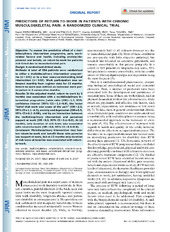Predictors of return to work in patients on sick leave with chronic musculoskeletal pain
Peer reviewed, Journal article
Published version

Åpne
Permanent lenke
https://hdl.handle.net/1956/18175Utgivelsesdato
2018Metadata
Vis full innførselSamlinger
Originalversjon
Journal of Rehabilitation Medicine. 2017, 50, 193-199. https://doi.org/10.2340/16501977-2296Sammendrag
Objective: To assess the predictive effect of a multidisciplinary intervention programme, pain, workrelated factors and health, including anxiety/depression and beliefs, on return-to-work for patients sick-listed due to musculoskeletal pain. Design: A randomized clinical study. Methods: A total of 284 patients were randomized to either a multidisciplinary intervention programme (n=141) or to a less resource-demanding brief intervention (n=143). Work participation was estimated monthly from register data for 12 months. Return-to-work was defined as increased work participation in 3 consecutive months. Results: In the adjusted model, return-to-work by 3 months was associated with a multidisciplinary intervention programme (odds ratio (OR)=2.7, 95% confidence interval (95% CI)=1.1–6.9), the factor “belief that work was cause of the pain” (OR=2.2, 95% CI=1.1–4.3), anxiety and depression (OR=0.5, 95% CI=0.2–0.98), and by an interaction between the multidisciplinary intervention and perceived support at work (OR=0.3, 95% CI=0.1–0.9). At 12 months, only duration of sick leave was associated with return-to-work (OR=0.6, 95% CI=0.5–0.8). Conclusion: Multidisciplinary intervention may hasten return-to-work and benefit those who perceive low support at work, but at 12 months only duration of sick leave at baseline was associated with returnto-work.
